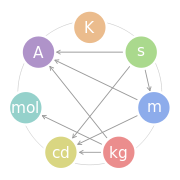Gray (unit)
The gray (symbol: Gy) is the SI unit of absorbed radiation dose of ionizing radiation (for example, X-rays), and is defined as the absorption of one joule of ionizing radiation by one kilogram of matter (usually human tissue)[1]. It supersedes the old cgs unit, the rad (10 mGy), which is now "strongly discouraged" by the author style guide of the U.S. National Institute of Standards and Technology.[2]
Contents |
Definition
One gray is the absorption of one joule of energy, in the form of ionizing radiation, by one kilogram of matter.
For X-rays and gamma rays, these are the same units as the sievert (Sv). To avoid any risk of confusion between the absorbed dose (by matter) and the equivalent dose (by biological tissues), one must use the corresponding special units, namely the gray instead of the joule per kilogram for absorbed dose and the sievert instead of the joule per kilogram for the dose equivalent. The unit gray spells out the same in both the singular and the plural.
This SI unit is named after Louis Harold Gray. As with every SI unit whose name is derived from the proper name of a person, the first letter of its symbol is uppercase (Gy). When an SI unit is spelled out in English, it should always begin with a lowercase letter (gray), except where any word would be capitalized, such as at the beginning of a sentence or in capitalized material such as a title. Note that "degree Celsius" conforms to this rule because the "d" is lowercase.—Based on The International System of Units, section 5.2.
Origin
The gray was defined in 1975 in honour of Louis Harold Gray (1905–1965), who used a similar concept, "that amount of neutron radiation which produces an increment of energy in unit volume of tissue equal to the increment of energy produced in unit volume of water by one röntgen of radiation," in 1940.
Explanation
The gray measures the deposited energy of radiation. The biological effects vary by the type and energy of the radiation and the organism and tissues involved. The sievert attempts to account for these variations. A whole-body exposure to 5 or more gray of high-energy radiation at one time usually leads to death within 14 days (see Radiation poisoning for details). This dosage represents 375 joules for a 75 kg adult (equivalent to the chemical energy in 20 mg of sugar). Since gray are such large amounts of radiation, medical use of radiation is typically measured in milligrays (mGy).
The average radiation dose from an abdominal x-ray is 1.4 mGy, that from an abdominal CT scan is 8.0 mGy, that from a pelvic CT scan is 25 mGy, and that from a selective spiral CT scan of the abdomen and the pelvis is 30 mGy.[3]
Conversions
1 rad is equal to 1 centigray, and 300 krad are equal to 3 kGy.
The röntgen is defined as the radiation exposure equal to the quantity of ionizing radiation that will produce one esu of electricity in one cubic centimetre of dry air at 0 °C and a standard atmosphere, and is conventionally taken to be worth 0.258 mC/kg (using a conventional air density of about 1.293 kg/m3). Using an air ionization energy of about 36.161 J/C, we have 1 Gy ≈ 115 R.
| Submultiples | Multiples | |||||
|---|---|---|---|---|---|---|
| Value | Symbol | Name | Value | Symbol | Name | |
| 10−1 Gy | dGy | decigray | 101 Gy | daGy | decagray | |
| 10−2 Gy | cGy | centigray | 102 Gy | hGy | hectogray | |
| 10−3 Gy | mGy | milligray | 103 Gy | kGy | kilogray | |
| 10−6 Gy | µGy | microgray | 106 Gy | MGy | megagray | |
| 10−9 Gy | nGy | nanogray | 109 Gy | GGy | gigagray | |
| 10−12 Gy | pGy | picogray | 1012 Gy | TGy | teragray | |
| 10−15 Gy | fGy | femtogray | 1015 Gy | PGy | petagray | |
| 10−18 Gy | aGy | attogray | 1018 Gy | EGy | exagray | |
| 10−21 Gy | zGy | zeptogray | 1021 Gy | ZGy | zettagray | |
| 10−24 Gy | yGy | yoctogray | 1024 Gy | YGy | yottagray | |
| Common multiples are in bold face. | ||||||
See also
- Dose area product (Gy·cm2)
- International System of Units base units
- SI derived unit to which Gray is part
- Rad (unit) the old unit for absorbed dose by matter
References
- ↑ "The International System of Units (SI)". Bureau International des Poids et Mesures (BIPM). http://www.bipm.org/utils/common/pdf/si_brochure_8_en.pdf. Retrieved 2010-01-31.
- ↑ "NIST Guide to SI Units - Units temporarily accepted for use with the SI". http://physics.nist.gov/Pubs/SP811/sec05.html#5.2.
- ↑ Baden, Jeffrey M.; Jay B. Brodsky (1985). The Pregnant surgical patient. London: Futura. ISBN 0-87993-238-4.
|
||||||||||||||||||||

